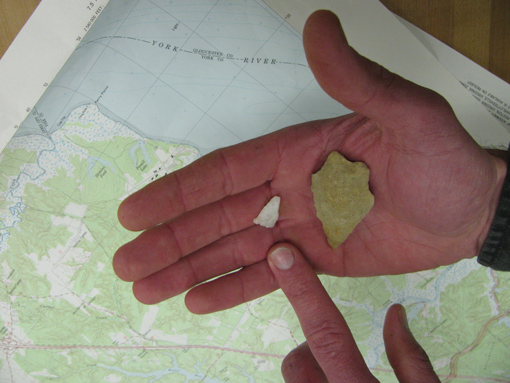Pocahontas' home town
Werowocomoco exhibit will feature first public showing of artifacts
After 400 years, copper traded by English colonists to the Indians will be coming back to Jamestown.
The copper pieces were recovered in the last several years by archaeologists at Werowocomoco, the capital city of Chief Powhatan, father of Pocahontas. They are among the artifacts to be displayed at "Werowocomoco: Seat of Power," a new exhibit at Jamestown Settlement to open in May.
William and Mary archaeologist Martin Gallivan notes that the copper is significant in the Werowocomoco-Jamestown story. Researchers have chemically linked the "Wero" copper to Jamestown. Also, copper had a socio-economic and spiritual significance to the Powhatan Indians. Copper, he said, is part of the evidence pointing to Wero as a place of political and spiritual power that was important for centuries before Jamestown.
"Nothing like Werowocomoco exists on the East Coast of America. Telling that story at an exhibit that's located elsewhere presents a serious challenge," Gallivan said. The exhibit centers around a three-dimensional model of 1607 Werowocomoco. Narrative panels will convey how the place was organized and how it served as the center of a chiefdom, known as Tsenacommacah, which encompassed the Virginia coastal plain and much of the Eastern Shore.
Gallivan and other members of the Werowocomoco Research Group, based at the College, have been excavating the Gloucester County site since 2003. They are collaborating on the exhibit with Thomas Davidson, senior curator at Jamestown Settlement, and members of the contemporary Virginia Indian community.
"The Werowocomoco
exhibit presents an opportunity to expand public knowledge of Virginia's past
by looking at Virginia Indian cultures from a new perspective. Conventional
exhibits that deal with Virginia before 1607 emphasize changes in the material
culture record, but ignore the political, social and belief contexts within which
these changes occur," said Davidson. "The exhibit demonstrates in a dramatic
fashion that Virginia's Indian heritage is not built up of pots and stone
tools, but of belief systems, family and community relationships, evolving
political systems, and a world view that was not derived from, or shared by,
the early English settlers at Jamestown," Davidson said. 
















